What We’re Reading: May 12th
Review: Synthetic biology approaches for the production of plant metabolites in unicellular organisms ($)
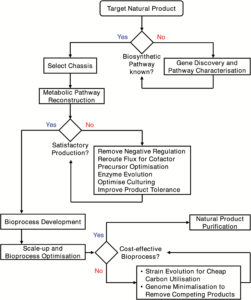 This excellent review by Moses et al. starts by defining the oft-confused terms metabolite engineering and systems biology. Although systems biology can contribute to the former, it is distinguished by the use of “defined ‘parts’ that are easily combined and exchanged, using standardized workflows and often combined with modelling and computational methods.” The authors go on to describe the use of systems biology tools for the production of high-value metabolites in single celled hosts (yeast, algae, and bacteria). This review spans a wide breadth of topics, from strengths and weakness of different unicellular hosts, to approaches for regulating gene expression level, and protein engineering and scaffolding. As well as providing a nice overview of this rapidly-advancing field for scientists, this review is also a great resource for use in teaching. J. Exp. Bot. 10.1093/jxb/erx119 Tags: Applied Plant Biology, Education and Outreach, Synthetic Biology
This excellent review by Moses et al. starts by defining the oft-confused terms metabolite engineering and systems biology. Although systems biology can contribute to the former, it is distinguished by the use of “defined ‘parts’ that are easily combined and exchanged, using standardized workflows and often combined with modelling and computational methods.” The authors go on to describe the use of systems biology tools for the production of high-value metabolites in single celled hosts (yeast, algae, and bacteria). This review spans a wide breadth of topics, from strengths and weakness of different unicellular hosts, to approaches for regulating gene expression level, and protein engineering and scaffolding. As well as providing a nice overview of this rapidly-advancing field for scientists, this review is also a great resource for use in teaching. J. Exp. Bot. 10.1093/jxb/erx119 Tags: Applied Plant Biology, Education and Outreach, Synthetic Biology
Review: Making plants break a sweat: the structure, function, and evolution of plant salt glands
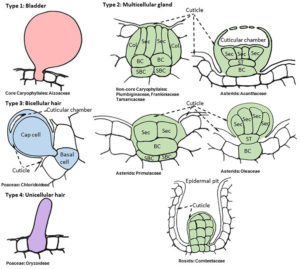 Many agricultural lands are becoming saltier as a consequence of irrigation and sea water incursion, yet most crops are very sensitive to salt. Salt glands that accumulate and secrete salt have evolved independently at least 12 times in plants. Dassanayake and Larkin review the structure, function and evolution of salt glands, and describe how model species with salt glands (including ice plant and quinoa) are useful for electrophysiology and genetic studies. The authors conclude with a fascinating thought-experiment about whether we could engineer salt glands into other species. The short answer: yes, in theory, but it “would be a substantial test of our skills in combining –omics data, cell biology, and classical whole plant physiology to understand and manipulate a plant’s response to environmental stress.” Front. Plant Science 10.3389/fpls.2017.00406 Tags: Abiotic Interactions, Botany, Cell Biology, Ecophysiology
Many agricultural lands are becoming saltier as a consequence of irrigation and sea water incursion, yet most crops are very sensitive to salt. Salt glands that accumulate and secrete salt have evolved independently at least 12 times in plants. Dassanayake and Larkin review the structure, function and evolution of salt glands, and describe how model species with salt glands (including ice plant and quinoa) are useful for electrophysiology and genetic studies. The authors conclude with a fascinating thought-experiment about whether we could engineer salt glands into other species. The short answer: yes, in theory, but it “would be a substantial test of our skills in combining –omics data, cell biology, and classical whole plant physiology to understand and manipulate a plant’s response to environmental stress.” Front. Plant Science 10.3389/fpls.2017.00406 Tags: Abiotic Interactions, Botany, Cell Biology, Ecophysiology
Review: Transfer and engineering of immune receptors to improve recognition capacities in crops ($)
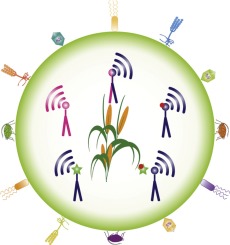 Cell-surface localized immune receptors are one of the ways that plants detect pathogens. Traditionally, these receptors have been introgressed from resistant to susceptible varieties through classical breeding. More recently, it has become possible to use genetic engineering methods to move immune receptor genes between more distantly-related plants, where they are able to confer resistance. Rodriguez-Moreno et al. review these trans-family gene transfers and also efforts to expand the recognition spectrum more broadly through directed evolution and gene editing. They also describe efforts to identify novel variants of intracellular nucleotide-binding domain leucine-rich repeat receptors (NLRs). However, they observe that “strategies based on the transfer of individual immune receptor genes can be rapidly overcome under field conditions, and pyramiding of immune receptors that recognize different ligands is imperative.” Curr. Opin. Plant Biol. 10.1016/j.pbi.2017.04.010 Tags: Applied Plant Biology, Biotic Interactions
Cell-surface localized immune receptors are one of the ways that plants detect pathogens. Traditionally, these receptors have been introgressed from resistant to susceptible varieties through classical breeding. More recently, it has become possible to use genetic engineering methods to move immune receptor genes between more distantly-related plants, where they are able to confer resistance. Rodriguez-Moreno et al. review these trans-family gene transfers and also efforts to expand the recognition spectrum more broadly through directed evolution and gene editing. They also describe efforts to identify novel variants of intracellular nucleotide-binding domain leucine-rich repeat receptors (NLRs). However, they observe that “strategies based on the transfer of individual immune receptor genes can be rapidly overcome under field conditions, and pyramiding of immune receptors that recognize different ligands is imperative.” Curr. Opin. Plant Biol. 10.1016/j.pbi.2017.04.010 Tags: Applied Plant Biology, Biotic Interactions
Review: Invasion science: A Horizon Scan of emerging challenges and opportunities ($)
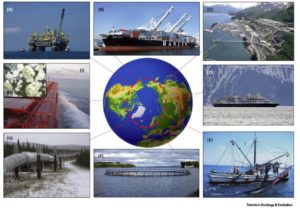 Ricciardi et al. describe the conclusions from a “horizon scanning” workshop set up “to identify emerging scientific, technological, and sociopolitical issues that are likely to affect how invasion processes and dynamics are studied and managed within the next 20 years.” Key concerns include expanding transportation networks, global environmental change, genomic modification tools (which offer both risks and potential solutions to managing invasions), the commercial use of microbes to facilitate crop production, and increased human activities in the Arctic. For each, the potential for harm and mitigation strategies are discussed. Trends Ecol. Evol. 10.1016/j.tree.2017.03.007 Tags: Ecology
Ricciardi et al. describe the conclusions from a “horizon scanning” workshop set up “to identify emerging scientific, technological, and sociopolitical issues that are likely to affect how invasion processes and dynamics are studied and managed within the next 20 years.” Key concerns include expanding transportation networks, global environmental change, genomic modification tools (which offer both risks and potential solutions to managing invasions), the commercial use of microbes to facilitate crop production, and increased human activities in the Arctic. For each, the potential for harm and mitigation strategies are discussed. Trends Ecol. Evol. 10.1016/j.tree.2017.03.007 Tags: Ecology
Silver birch: Genome sequence and population genomic analyses
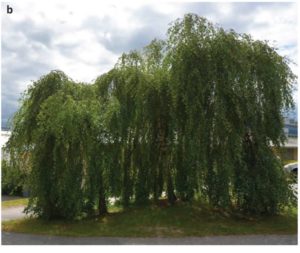 Salojärvi et al. have assembled the genome of silver birch (Betula pendula) and examined genomic diversity across 150 individuals collected from Northern Europe and Asia. Their study shows that there have been several genetic bottlenecks associated with climate upheaval (e.g., at the K-Pg boundary 66 million years ago). They also find evidence of short genome duplications that amplify genes involved in responses to the environment. They identify variations in several genes correlated with different environments, such as the light responsive genes PHYC and FRS10 that show variation associated with latitude, longitude and temperature. Because silver birch has been developed as a model, these new insights are likely to find applications in forest biotechnology, for example towards improving wood production and the resilience of trees towards temperature anomalies. Nature Genetics 10.1038/ng.3862 Tags: Botany, Evolution, Genomics
Salojärvi et al. have assembled the genome of silver birch (Betula pendula) and examined genomic diversity across 150 individuals collected from Northern Europe and Asia. Their study shows that there have been several genetic bottlenecks associated with climate upheaval (e.g., at the K-Pg boundary 66 million years ago). They also find evidence of short genome duplications that amplify genes involved in responses to the environment. They identify variations in several genes correlated with different environments, such as the light responsive genes PHYC and FRS10 that show variation associated with latitude, longitude and temperature. Because silver birch has been developed as a model, these new insights are likely to find applications in forest biotechnology, for example towards improving wood production and the resilience of trees towards temperature anomalies. Nature Genetics 10.1038/ng.3862 Tags: Botany, Evolution, Genomics
Growth is required for perception of water availability to pattern plant root branches
 Plant roots develop on a very heterogeneous environment surrounded by a myriad of environmental clues that can change at different spatiotemporal scales. The ability of roots to sense and respond to these clues is fundamental to ensure an efficient exploration of the rhizosphere. In this paper, Robbins and Dinneny show that root growth is necessary for roots to be able to sense microenvironments with different levels of water availability. This growth-by-sense mechanism is fundamental to then initiate the lateral root branching into soil areas with high water content. The authors developed a regression model and an associated application where different parameters involved in this process can be changed to simulate lateral root emergence patterns. (Summary by Rubén Rellán-Álverez) BioRxiv http://biorxiv.org/content/early/2017/01/02/097758 Tags: Abiotic Interactions, Computational Biology, Growth Regulation
Plant roots develop on a very heterogeneous environment surrounded by a myriad of environmental clues that can change at different spatiotemporal scales. The ability of roots to sense and respond to these clues is fundamental to ensure an efficient exploration of the rhizosphere. In this paper, Robbins and Dinneny show that root growth is necessary for roots to be able to sense microenvironments with different levels of water availability. This growth-by-sense mechanism is fundamental to then initiate the lateral root branching into soil areas with high water content. The authors developed a regression model and an associated application where different parameters involved in this process can be changed to simulate lateral root emergence patterns. (Summary by Rubén Rellán-Álverez) BioRxiv http://biorxiv.org/content/early/2017/01/02/097758 Tags: Abiotic Interactions, Computational Biology, Growth Regulation
Root hydrotropism is controlled via a cortex-specific growth mechanism ($)
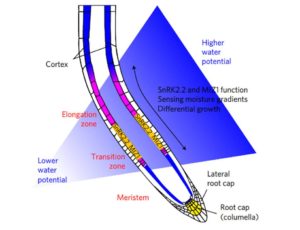 Hydrotropism is the curvature of a plant root towards water. Previous work showed that the hormone abscisic acid (ABA), but not the auxin transporters AUX1 and PIN, is required for hydrotropism, demonstrating that the mechanisms of hydrotropism and gravitropism are distinct. Previous work also showed that MIZU-KUSSEI1 (MIZ1), a gene of unknown function, is required for hytrotropism. In this new work, Dietrich et al. showed that an ABA-responsive protein kinase is required for hydrotropism, and further, that expression of both SnRK2.2 and MIZ1 in the root cortex is needed for hydrotropism. Furthermore, the root cap and root meristem do not seem to be involved in the perception and response to a water gradient. Nature Plants 10.1038/nplants.2017.57 Tags: Abiotic Interactions, Genetics, Growth Regulation
Hydrotropism is the curvature of a plant root towards water. Previous work showed that the hormone abscisic acid (ABA), but not the auxin transporters AUX1 and PIN, is required for hydrotropism, demonstrating that the mechanisms of hydrotropism and gravitropism are distinct. Previous work also showed that MIZU-KUSSEI1 (MIZ1), a gene of unknown function, is required for hytrotropism. In this new work, Dietrich et al. showed that an ABA-responsive protein kinase is required for hydrotropism, and further, that expression of both SnRK2.2 and MIZ1 in the root cortex is needed for hydrotropism. Furthermore, the root cap and root meristem do not seem to be involved in the perception and response to a water gradient. Nature Plants 10.1038/nplants.2017.57 Tags: Abiotic Interactions, Genetics, Growth Regulation
Inhibition of jasmonic acid biosynthesis by ethylene promotes elongation of etiolated rice seedlings
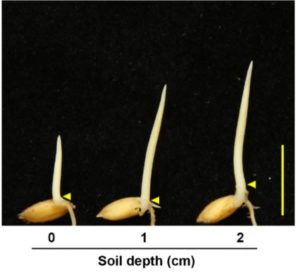 During germination, the rice shoot is protected by the coleoptile, which is a highly light and hormone-sensitive tissue. While searching for genes involved in ethylene responses, Xiong et al. identified a mutant with an elongated coleoptile, in which the subtending mesocotyl is also elongated; they named this mutant gaoyao1 (gy1), a Chinese name meaning “high waist”. Map-based cloning revealed that GY1 encodes a plastid-localized phospholipase involved in the synthesis of jasmonic acid (JA). They found that ethylene (which promotes coleoptile elongation) represses expression of GY1, and that JA represses coleoptile growth. Furthermore, they found natural allelic variation of the GY1 gene associated with longer coleoptiles. These findings provide new insights into the regulation of seedling establishment and can be used to select for coleoptile length in breeding programs. Plant Cell 10.1105/tpc.16.00981 Tags: Genetics, Growth Regulation, Signals and Responses
During germination, the rice shoot is protected by the coleoptile, which is a highly light and hormone-sensitive tissue. While searching for genes involved in ethylene responses, Xiong et al. identified a mutant with an elongated coleoptile, in which the subtending mesocotyl is also elongated; they named this mutant gaoyao1 (gy1), a Chinese name meaning “high waist”. Map-based cloning revealed that GY1 encodes a plastid-localized phospholipase involved in the synthesis of jasmonic acid (JA). They found that ethylene (which promotes coleoptile elongation) represses expression of GY1, and that JA represses coleoptile growth. Furthermore, they found natural allelic variation of the GY1 gene associated with longer coleoptiles. These findings provide new insights into the regulation of seedling establishment and can be used to select for coleoptile length in breeding programs. Plant Cell 10.1105/tpc.16.00981 Tags: Genetics, Growth Regulation, Signals and Responses
Metal Tolerance Protein 8 mediates Mn and Fe homeostasis in seeds
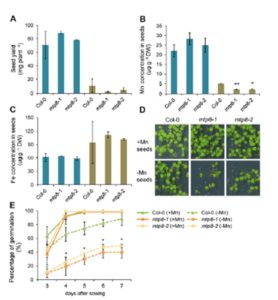 Plants and seeds are the main dietary source of essential micronutrients in the food chain. The processes regulating transport of micronutrients to and within seeds are critical for germination and enrichment of seeds. Metal transport protein 8 (MTP8) has been characterized as a tonoplast Mn transporter in Arabidopsis roots preventing plants from Mn toxicity. In this paper the authors further characterize the role of MTP8 in Arabidopsis. Using yeast as a heterologous expression system, Eroglu et al. demonstrated that MTP8 restores the growth of a yeast mutant defective in vacuolar Fe transport. They further report that the MTP8 is also responsible for a characteristic enrichment of Mn in cortical cells of the hypocotyl and in subepidermal cells of cotyledons, as well as for Mn homeostasis during imbibition and germination under changing water conditions. (Summary by Mather Khan) Plant Physiol. 10.1104/pp.16.01646 Tags: Physiology, Transport
Plants and seeds are the main dietary source of essential micronutrients in the food chain. The processes regulating transport of micronutrients to and within seeds are critical for germination and enrichment of seeds. Metal transport protein 8 (MTP8) has been characterized as a tonoplast Mn transporter in Arabidopsis roots preventing plants from Mn toxicity. In this paper the authors further characterize the role of MTP8 in Arabidopsis. Using yeast as a heterologous expression system, Eroglu et al. demonstrated that MTP8 restores the growth of a yeast mutant defective in vacuolar Fe transport. They further report that the MTP8 is also responsible for a characteristic enrichment of Mn in cortical cells of the hypocotyl and in subepidermal cells of cotyledons, as well as for Mn homeostasis during imbibition and germination under changing water conditions. (Summary by Mather Khan) Plant Physiol. 10.1104/pp.16.01646 Tags: Physiology, Transport
Regulating plant physiology with organic electronics
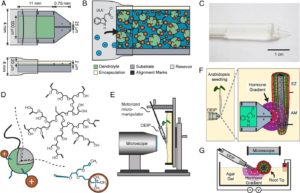 Many insights about hormone function have come from “spray and pray” studies, but generally the precision of application of the hormone limits their value. Poxson et al. describe an adaption of an organic electronic ionic pump (OEIP; developed originally for studies of mammalian cells) for introducing small quantities of the hormone auxin to a precise location. For use in these studies, the OEIP was adapted to incorporate hyperbranched polymers (dendrolytes) as a matrix. Auxin movement and release from the pump is controlled electronically. The authors demonstrated the effectiveness of IAA delivery through root growth rate and positive and negative reporters (35S::DII-Venus or DR5rev::GFP). This study demonstrates the potential for the application of OEIP technology toward plant research. Proc. Natl. Acad. Sci. USA Tags: Growth Regulation, Signals and Responses
Many insights about hormone function have come from “spray and pray” studies, but generally the precision of application of the hormone limits their value. Poxson et al. describe an adaption of an organic electronic ionic pump (OEIP; developed originally for studies of mammalian cells) for introducing small quantities of the hormone auxin to a precise location. For use in these studies, the OEIP was adapted to incorporate hyperbranched polymers (dendrolytes) as a matrix. Auxin movement and release from the pump is controlled electronically. The authors demonstrated the effectiveness of IAA delivery through root growth rate and positive and negative reporters (35S::DII-Venus or DR5rev::GFP). This study demonstrates the potential for the application of OEIP technology toward plant research. Proc. Natl. Acad. Sci. USA Tags: Growth Regulation, Signals and Responses
An animal-like cryptochrome controls the Chlamydomonas sexual cycle ($)
 Light controls many aspects of the lifecycle of photosynthetic organisms, including the green alga Chlamydomonas. Cryptochromes are a family of photoreceptors, of which there are four members in Chlamydomonas. One of these is known as the animal-type cryptochrome, aCRY. To investigate the function of aCRY, Zou et al. generated insertional mutants in aCRY that knocked down the protein level to less than 20% of wildtype. The mutant reveals that aCRY has both positive and negative roles in the mating cycle of the alga. Plant Physiol. 10.1104/pp.17.00493 Tags: Growth Regulation, Signals and Responses
Light controls many aspects of the lifecycle of photosynthetic organisms, including the green alga Chlamydomonas. Cryptochromes are a family of photoreceptors, of which there are four members in Chlamydomonas. One of these is known as the animal-type cryptochrome, aCRY. To investigate the function of aCRY, Zou et al. generated insertional mutants in aCRY that knocked down the protein level to less than 20% of wildtype. The mutant reveals that aCRY has both positive and negative roles in the mating cycle of the alga. Plant Physiol. 10.1104/pp.17.00493 Tags: Growth Regulation, Signals and Responses
Early history of Arabidopsis thaliana
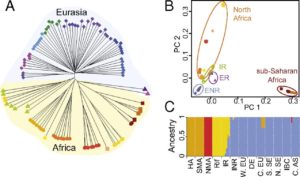 Arabidopsis thaliana is a good study system to shed light on evolutionary processes. Its broad native range and genetic diversity provide resources to study speciation and local adaptation. Durvasula et al. studied the early history and transition to selfing of this species by comparing genome sequences of populations native to Eurasia and Africa. They found that speciation most likely occurred in Africa, where populations first transitioned to selfing. In addition, population dynamics are coincident with known climate shifts and demographic events of other species, including humans. (Summary by Gaby Auge) Proc. Natl. Acad. Sci. USA Tags: Botany, Evolution, Genomics
Arabidopsis thaliana is a good study system to shed light on evolutionary processes. Its broad native range and genetic diversity provide resources to study speciation and local adaptation. Durvasula et al. studied the early history and transition to selfing of this species by comparing genome sequences of populations native to Eurasia and Africa. They found that speciation most likely occurred in Africa, where populations first transitioned to selfing. In addition, population dynamics are coincident with known climate shifts and demographic events of other species, including humans. (Summary by Gaby Auge) Proc. Natl. Acad. Sci. USA Tags: Botany, Evolution, Genomics
Hybridizing transgenic Bt cotton with non-Bt cotton counters resistance in pink bollworm
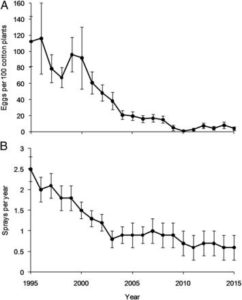 Biotic interactions are complex; any effort by the prey/host to defend against the predator/pathogen provides selective pressure towards overcoming those defenses. As new herbivore control methods are developed they quickly lose effectiveness as the pests evolve resistance; this is true whether the control method is sprayed externally or produced internally as it is in transgenic crops expressing Bacillus thuringiensis (Bt) protein. Wan et al. report on an 11-year study in China in which the cotton planted was the F2 generation from a cross between Bt plants and non-Bt plants (in the F2 generation 75% of the plants express the dominant Bt trait). The authors found that resistance to Bt in pink bollworm was substantially delayed, as the non-Bt plants provide a refuge for susceptible individuals. Because the insects were successfully controlled, insect population and insecticidal spray use both declined during this period. The authors propose that the hybridization-based strategy might be an effective alternative where refuge planting is impractical. Proc. Natl. Acad. Sci. USA 10.1073/pnas.1700396114 Tags: Applied Plant Biology, Biotic Interactions, Genetics
Biotic interactions are complex; any effort by the prey/host to defend against the predator/pathogen provides selective pressure towards overcoming those defenses. As new herbivore control methods are developed they quickly lose effectiveness as the pests evolve resistance; this is true whether the control method is sprayed externally or produced internally as it is in transgenic crops expressing Bacillus thuringiensis (Bt) protein. Wan et al. report on an 11-year study in China in which the cotton planted was the F2 generation from a cross between Bt plants and non-Bt plants (in the F2 generation 75% of the plants express the dominant Bt trait). The authors found that resistance to Bt in pink bollworm was substantially delayed, as the non-Bt plants provide a refuge for susceptible individuals. Because the insects were successfully controlled, insect population and insecticidal spray use both declined during this period. The authors propose that the hybridization-based strategy might be an effective alternative where refuge planting is impractical. Proc. Natl. Acad. Sci. USA 10.1073/pnas.1700396114 Tags: Applied Plant Biology, Biotic Interactions, Genetics
Transcriptome analysis illuminates the nature of the intracellular interaction in a vertebrate-algal symbiosis
 Chloroplasts are of course the descendants of ancient endosymbiotic cyanobacteria. While there are examples of photosynthetic bacteria or algae living in animal tissues (e.g., anemones and corals), vertebrate endosymbiosis is rare. One exception is the interaction between a salamander Ambystoma maculatum and the green alga Oophila amblystomatis, which lives on and within the salamander’s eggs (oophila means egg-lover). The metabolic interactions between the two species have not been fully understood. Burns et al. took a transcriptomic approach, comparing the free-living, within-egg and on-egg algal transcriptomes, as well as those of the salamander host with and without the symbiont. Interestingly, one finding is that the algae within the cell are oxygen-deprived and may rely on fermentation for energy production, calling into question what benefit they get from this interaction. As the authors conclude, “Whether the intracellular algae are on the positive end of a net host benefit remains uncertain, however it is clear that the algae have an unconventional ‘photosymbiont’ role.” eLIFE 10.7554/eLife.22054 Tags: Biochemistry, Biotic Interaction, Ecology
Chloroplasts are of course the descendants of ancient endosymbiotic cyanobacteria. While there are examples of photosynthetic bacteria or algae living in animal tissues (e.g., anemones and corals), vertebrate endosymbiosis is rare. One exception is the interaction between a salamander Ambystoma maculatum and the green alga Oophila amblystomatis, which lives on and within the salamander’s eggs (oophila means egg-lover). The metabolic interactions between the two species have not been fully understood. Burns et al. took a transcriptomic approach, comparing the free-living, within-egg and on-egg algal transcriptomes, as well as those of the salamander host with and without the symbiont. Interestingly, one finding is that the algae within the cell are oxygen-deprived and may rely on fermentation for energy production, calling into question what benefit they get from this interaction. As the authors conclude, “Whether the intracellular algae are on the positive end of a net host benefit remains uncertain, however it is clear that the algae have an unconventional ‘photosymbiont’ role.” eLIFE 10.7554/eLife.22054 Tags: Biochemistry, Biotic Interaction, Ecology
Ten simple rules to make the most out of your undergraduate research career
 Undergraduate research is a transformative experience for many early-career scientists, allowing them to experience the joys and pains of research first hand. Yu and Kuo offer some straightforward advice to help students gain the most from this opportunity. While some of the advice is directed towards computational biology students, most is broadly applicable (as in “Be organized”). This is a useful paper to pass on to young researchers! PLOS Comp Biol. 10.1371/journal.pcbi.1005484 Tags: Education and Outreach
Undergraduate research is a transformative experience for many early-career scientists, allowing them to experience the joys and pains of research first hand. Yu and Kuo offer some straightforward advice to help students gain the most from this opportunity. While some of the advice is directed towards computational biology students, most is broadly applicable (as in “Be organized”). This is a useful paper to pass on to young researchers! PLOS Comp Biol. 10.1371/journal.pcbi.1005484 Tags: Education and Outreach




Leave a Reply
Want to join the discussion?Feel free to contribute!